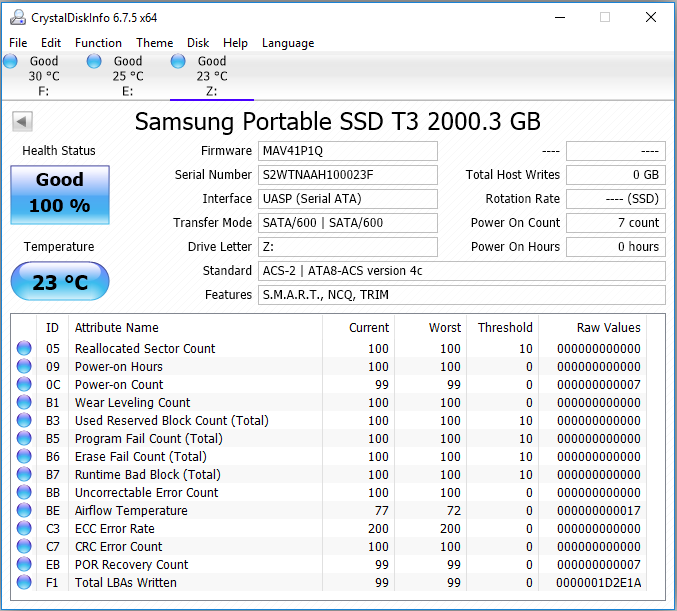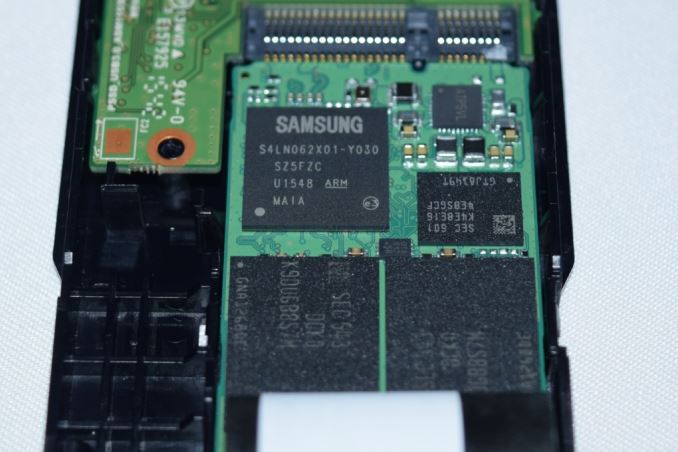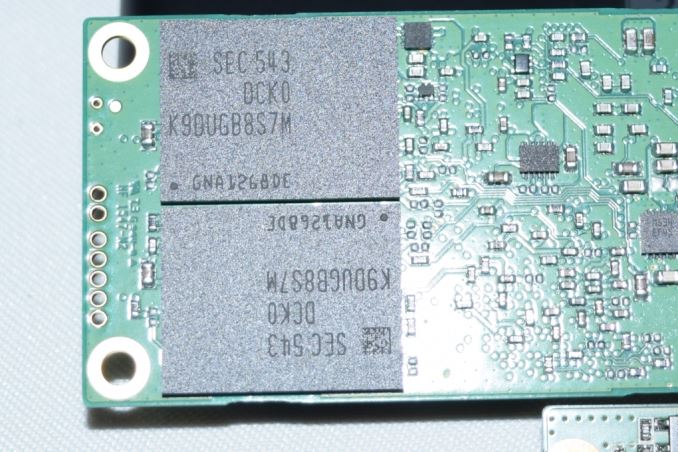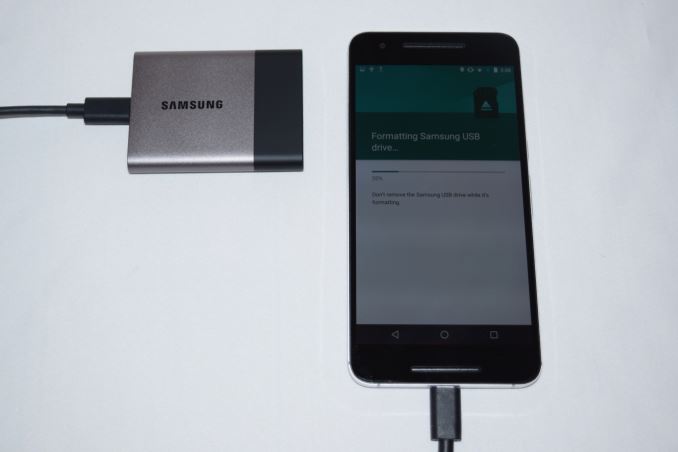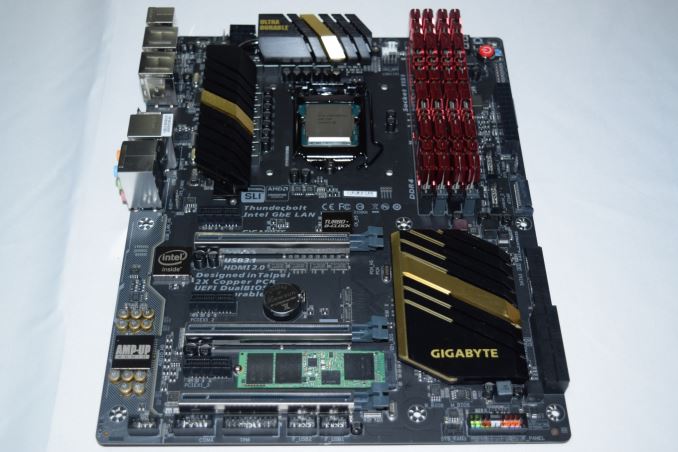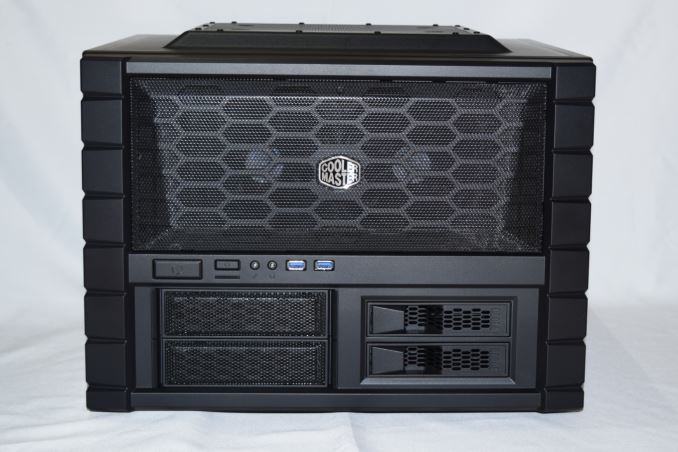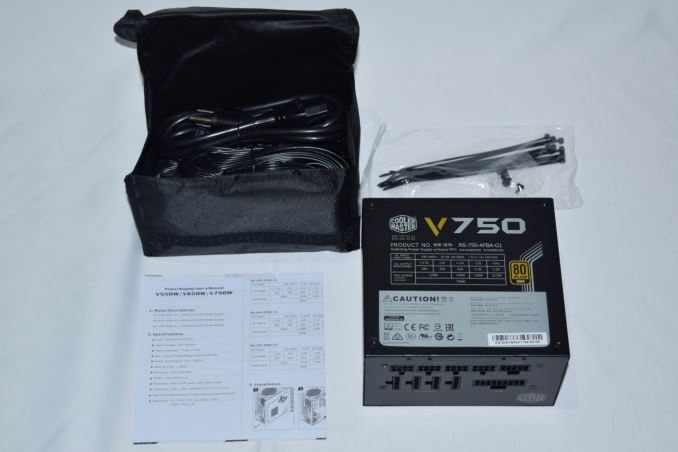
Original Link: https://www.anandtech.com/show/10057/samsung-portable-ssd-t3-review
Samsung Portable SSD T3 Review
by Ganesh T S on February 22, 2016 10:00 AM EST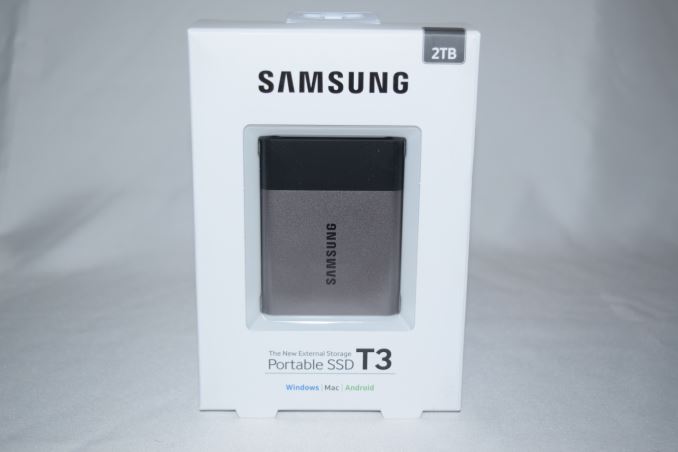
The last few years have seen rapid advancements in flash technology including planar 1x nm NAND, TLC, and 3D V-NAND. External high-speed interfaces such as USB 3.x have also become ubiquitous. The advent of Type-C has also enabled device vendors to agree upon a standardized connector for their equipment (be it mobile devices or desktop PCs). These advances have led to the appearance of small and affordable direct attached storage units with very high performance for day-to-day data transfer applications.
Introduction
There are plenty of options for high-capacity thumb drives, but the form factor brings in performance limitations. Therefore, vendors such as Samsung and SanDisk have decided to go in for palm-sized bus-powered units connecting to the host with the help of a cable. Samsung's Portable SSD T1 was released at CES 2015. The Portable SSD T3, announced at CES 2016, builds upon the market success of the T1 and comes with four main improvements:
- Bump in the maximum capacity from 1TB in the T1 to 2TB in the T3
- Migration from a micro-USB connector in the T1 to a USB 3.1 Gen 1 Type-C interface in the T3
- Official compatibility with Android - even for volumes secured with AES-256
- Partial metal enclosure to improve heat dissipation in the T3 compared to the all-plastic T1
The T3 units are slated to become available in the market towards the end of February, but Samsung provided the press with early samples.
The T1 was based on the 850 EVO (same 32-layer TLC V-NAND with a full-fledged MEX/MGX controller coupled with an ASMedia ASM1153E SATA to USB 3.0 bridge). However, the T3 is a bit of a puzzle, since the only 2TB variants we have had from Samsung are the 850 EVO and the 850 PRO. These 2TB variants both use eight 16-die packages (with the only difference being the MLC V-NAND in the Pro to the TLC V-NAND in the EVO). Accommodating eight flash packages in the footprint of the T3 seems like a big stretch, but, before we get into the internals, let us take a look at the insights provided by CrystalDiskInfo.
Even though CrystalDiskInfo reports TRIM as a feature, the quick TRIMCheck program pointed to TRIM availability being indeterminate. In any case, Samsung also doesn't make any claims about TRIM support. S.M.A.R.T data was not visible to most of the commonly used tools. On the USB 3.0 side, the drive supports UASP (USB-attached SCSI Protocol) that should provide increased performance for sequential transfers. Claimed transfer rates are 450 MBps for sequential accesses. We also have hardware-accelerated AES-256 encryption.
In the rest of this section, we will take a look at the internal hardware followed by some usage impressions (particularly from the viewpoint of a DAS unit for an Android device).
Internal Hardware
Compared to the T1, the T3 is much more easy to disassemble. This is not something that any end-user would really care about, but it definitely revealed some interesting information. The process involved peeling off two stickers and taking out four screws. Various pictures from our disassembly process (including shots of the heavy thermal protection) are available in the gallery below.
The last picture in the gallery shows the ASMedia 1153E SATA to USB 3.0 bridge chip (also used in the T1), as well as the ASM1542 10Gbps signal passive switch (used to enable the Type-C interface). The more interesting components are the controller and the flash packages. While the controller (S4LN062X01) seems to be the standard MGX controller used in the 120 - 500GB 850 EVO drives, there are only four flash packages in the system.
Given the 2TB capacity, it is clear that we are looking at flash packages that have not been used in any other publicly available Samsung storage device till now.
Maybe a bit too much flash on the flash?
The flash packages carry the marking K9DUGB8S7M. Since each package has 500 GB of flash, there are three possibilities:
- 32-layer TLC V-NAND, but, 32 dies per package instead of the 16-die ones used in the 850 EVO SATA SSDs
- 32-layer TLC V-NAND, 16 dies per package, but, 256 Gb dies instead of the 128 Gb ones used in the 850 EVO SATA SSDs
- 48-layer TLC V-NAND, 16 dies per package with 256 Gb dies
Without any further details from Samsung, our educated guess is that (c) looks to be the most likely option. The first clue is the pricing. At $850 for 2TB ($0.425/GB), it is not the cheapest external SSD around. The cost per GB is higher than that of the T1 (which launched at $0.60/GB and has now moved down to around $0.34/GB). This leads us to suspect that this is the latest generation TLC V-NAND. An external device like the T3 would allow Samsung to first ship the flash in a low-volume, high-profit part, and then ramp it up for consumer SSDs.There is also less concern about performance and endurance compared to the requirements in internal SSDs. Samsung had also talked about 256 Gb 48-layer TLC V-NAND mass production at FMS last August, and the flash packages in T3 look most likely to be based on that. UPDATE: Samsung confirmed that the NAND used in the Portable SSD T3 is indeed 48-layer 256 Gb TLC V-NAND.
Usage Impressions
Unlike the T1 which came pre-partitioned with a 128 MB FAT32 volume and the rest of the capacity formatted in exFAT, the T3 has only one exFAT partition. Samsung's Portable SSD program can be installed on the PC to enable or disable security (the AES-256 option) as well as to enter the password for drives that have had a password set through another device. We saw in our T1 review that the encryption is done in hardware, and there is no performance penalty. Since the claimed performance numbers are also not different from the T1, we benchmarked the drive with the encryption disabled.
Coming back to the usage aspects, the exFAT volume is available without installing any special programs on both Windows and Mac OS systems. Linux users might need to install an external package to get exFATsupport. Though Samsung claims Android support for the unit, it is only for the encryption aspect. The Portable SSD app allows users to enable / disable / unlock the encryption (security) on a drive.
We attached the T3 to a Huawei Nexus 6P using the Type-C to Type-C cable that came along with the phone. There was no trouble accessing the drive on the phone.
The only caveat is that Android doesn't support exFAT. I thought Samsung's Portable SSD app would enable exFAT support, but that is not the case currently. Anyways, the Nexus 6P force-formatted the T3 in FAT32, but, after that, there was no issue in transferring data between the phone and a PC using the T3.
On the whole, the user experience with the T3 was definitely better than what we had with the T1 at launch. Android compatibility is nice to have, but we would definitely like Samsung to provide exFAT support through the Portable SSD app. In the next section, we will describe our testbed setup and testing methodology for the Samsung Portable SSD T3 unit.
The Skylake DAS Testbed Build
The rising popularity of USB 3.1 (both Gen 1 and Gen 2) Type-C direct-attached storage (DAS) devices and the upcoming Thunderbolt 3 DAS units made it clear that I had to work on some updates to our direct-attached storage testbed. Originally based on the Haswell platform, the DAS testbed used a Thunderbolt 2 PCIe add-on card and the USB 3.0 ports hanging off the PCH. For a brief while, I also added USB 3.1 Gen 2 Type-A and Type-C PCIe cards to evaluate a few DAS units.
The introduction of Skylake has been quite interesting from the viewpoint of fast local storage. While the 100-series chipset doesn't have native USB 3.1 Gen 2 support, it does have plenty of high-speed PCIe 3.0 lanes that enable high-speed bridges to other protocols. Motherboard vendors have decided to enable USB 3.1 on entry-level boards with an ASMedia bridge chip. However, premium boards can be equipped with Intel's own Alpine Ridge controller.
Thunderbolt 3 and Intel's Apline Ridge are interesting for a few reasons (I will go more in detail into these in the review of our first Thunderbolt 3 DAS unit):
- In addition to Thunderbolt 3, Alpine Ridge also integrates a USB 3.1 Gen 2 (10 Gbps) host controller
- Thunderbolt 3 works over a Type-C interface, and supports a couple of additional protocols - USB 3.1 Gen 2 and DisplayPort 1.2
Considering these aspects, it made sense to migrate to Skylake for our DAS testbed. In particular, I looked out for a board with Alpine Ridge integrated. Ian published the review of the GIGABYTE Z170X-UD5 TH last Friday, and it turned out that the board perfectly fit the requirements. Intel provided us with a sample of the Core i5-6600K to use in the board. G.Skill also came forward with four 8GB DDR4 DIMMs to give the testbed 32GB of DRAM (the same as our Haswell-based testbed)
The Corsair Carbide Series Air 540 chassis in our Haswell-based testbed has been great in terms of footprint, ventilation and easy access to components. Two hot-swap internal SATA slots turned out to be a boon for quick secure erases of SSDs as well as benchmarking of internal HDDs meant for NAS usage in the single-disk mode. However, this unintended usage model (I wasn't planning on doing this frequently when I first opted for the Corsair Air 540) was a bit of a hassle, since one of the chassis sides had to be dismounted to access the hot-swap slots. I wanted to address this issue in the new testbed.
In the lookout for a ATX chassis for the new testbed, I had three main requirements:
- Hot-swap bays accessible without the need to open up the unit (similar to the drive slots in hot-swap NAS units)
- Portability in terms of being easy to shift from one location in the lab to another (something I realized as important when trying to test daisy chaining with a Thunderbot 2 DAS unit last year)
- Cubical footprint with horizontal motherboard orientation in order to better fit in a workbench and enable easy swapping out of PCIe cards in the future
The Cooler Master HAF XB EVO perfectly fit our requirements. The two X-Dock bays fulfilled our need for hot-swap bays for both 3.5" and 2.5" drives. Since the unit is marketed as a LAN box, it has two rigid carry handles on the side panels to enable portability. The unit can also easily serve as a testbench. Only the top cover (held in place by two screws at the back) needs to be removed in order to access the PCIe cards. The PSU slot also extends slightly out, enabling easier cable management inside the chassis. With plenty of additional drive slots in addition to the X-Dock, it was a no-brainer to go with the Cooler Master HAF XB EVO.
We have traditionally gone with the chassis vendor for the PSU also in our testbeds. Cooler Master suggested the fully modular V750 for use in our system.
Even though a 750W PSU is an overkill for a system with no discrete GPUs, the rating makes sure that we have the option in the future. The fully modular nature also helped greatly in cable management.
In addition to the above, we made use of a few components that were salvaged from earlier reviews / unused components from previous builds - a Corsair Hydro Series H105 liquid CPU cooler, a Samsung SM951 NVMe PCIe 3.0 x4 SSD for the boot drive, and an Intel 730 series 480 GB SSD and a Corsair Neutron XT 480 GB SSD for use as staging drives for temporary data. The gallery below provides some more pictures from our build process.
Evaluation of DAS units on Windows is being done with the testbed outlined in the table below. For devices with a USB 3.1 Gen 1 (USB 3.0 via a Type-C interface) connections (such as the Samsung Portable SSD T3 2TB that we are considering today), we utilize the USB 3.1 Type-C port enabled by the Intel Alpine Ridge controller. It connects to the Z170 PCH via a PCIe 3.0 x4 link..
| AnandTech DAS Testbed Configuration | |
| Motherboard | GIGABYTE Z170X-UD5 TH ATX |
| CPU | Intel Core i5-6600K |
| Memory | G.Skill Ripjaws 4 F4-2133C15-8GRR 32 GB ( 4x 8GB) DDR4-2133 @ 15-15-15-35 |
| OS Drive | Samsung SM951 MZVPV256 NVMe 256 GB |
| SATA Devices | Corsair Neutron XT SSD 480 GB Intel SSD 730 Series 480 GB |
| Add-on Card | None |
| Chassis | Cooler Master HAF XB EVO |
| PSU | Cooler Master V750 750 W |
| OS | Windows 10 Pro x64 |
| Thanks to Cooler Master, GIGABYTE, G.Skill and Intel for the build components | |
The list of DAS units used for comparison purposes is provided below.
- Samsung Portable SSD T3 2TB
- Corsair Voyager GTX v2 256GB
- LaCie Rugged Thunderbolt 500GB
- Samsung Portable SSD T1 1TB - No Encryption
- SanDisk Extreme 500 240GB - USB 3.0
Synthetic Benchmarks - ATTO and Crystal DiskMark
Samsung claims sequential read and write speeds of up to 450 MBps, and these are backed up by the ATTO benchmarks provided below. Unfortunately, these access traces are not very common in real-life scenarios.
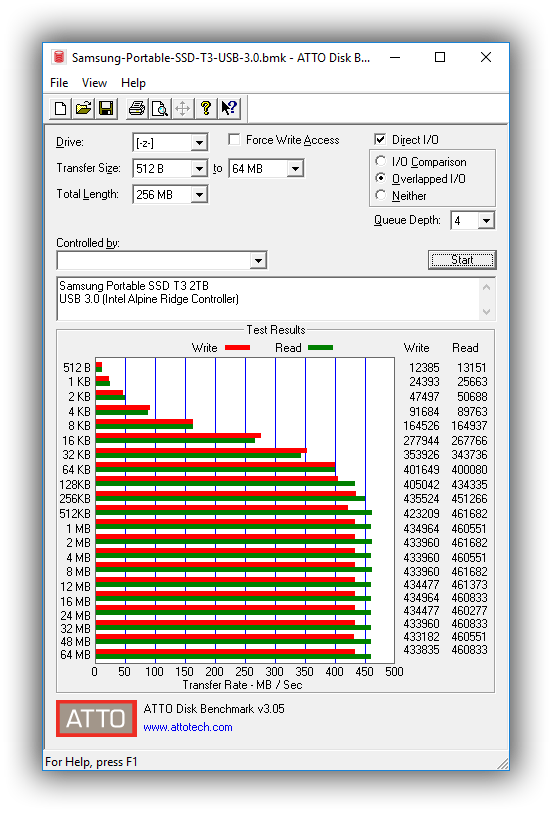
CrystalDiskMark, despite being a canned benchmark, provides a better estimate of the performance range with a selected set of numbers. As evident from the screenshot below, the performance can dip to as low as 20.68 MBps for random 4K reads. The presence of DRAM helps boost the performance quite a bit.
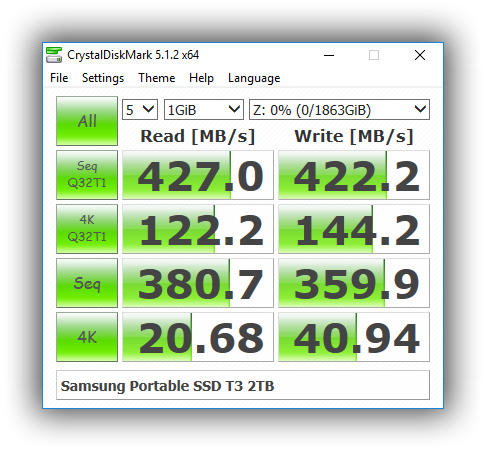
Benchmarks - robocopy and PCMark 8 Storage Bench
Our testing methodology for DAS units also takes into consideration the usual use-case for such devices. The most common usage scenario is transfer of large amounts of photos and videos to and from the unit. The minor usage scenario is importing files directly off the DAS into a multimedia editing program such as Adobe Photoshop.
In order to tackle the first use-case, we created three test folders with the following characteristics:
- Photos: 15.6 GB collection of 4320 photos (RAW as well as JPEGs) in 61 sub-folders
- Videos: 16.1 GB collection of 244 videos (MP4 as well as MOVs) in 6 sub-folders
- BR: 10.7 GB Blu-ray folder structure of the IDT Benchmark Blu-ray (the same that we use in our robocopy tests for NAS systems)
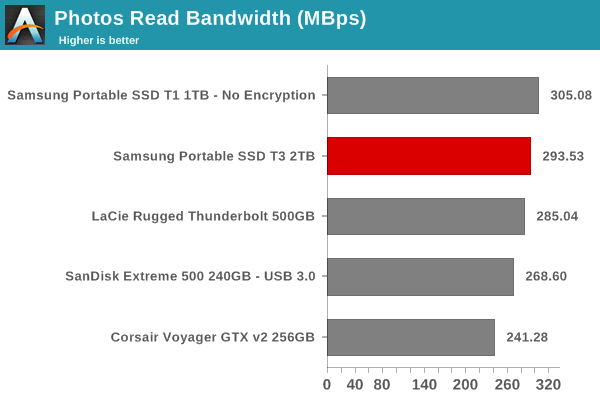
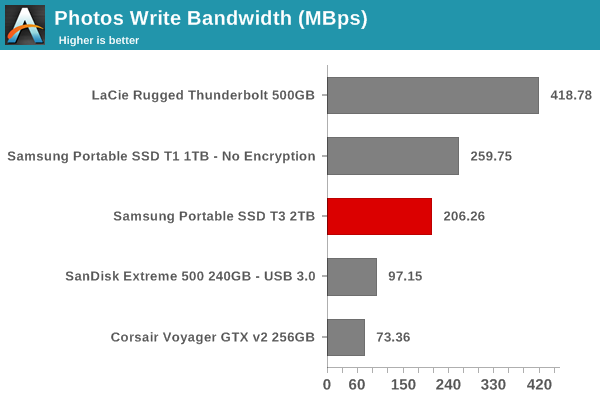
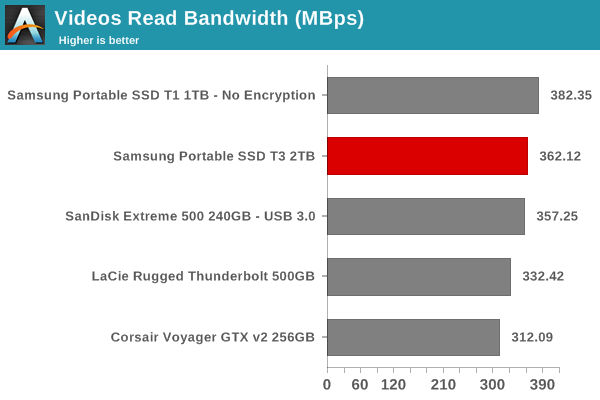
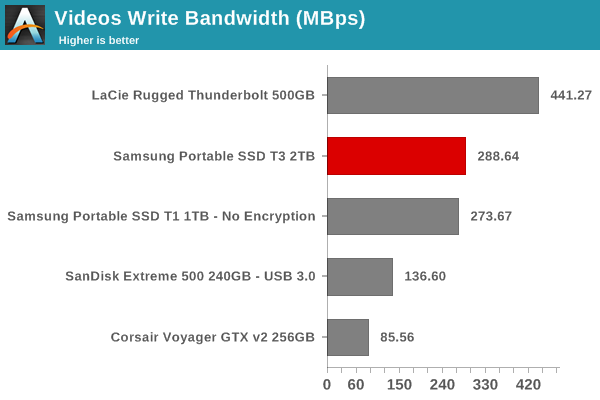
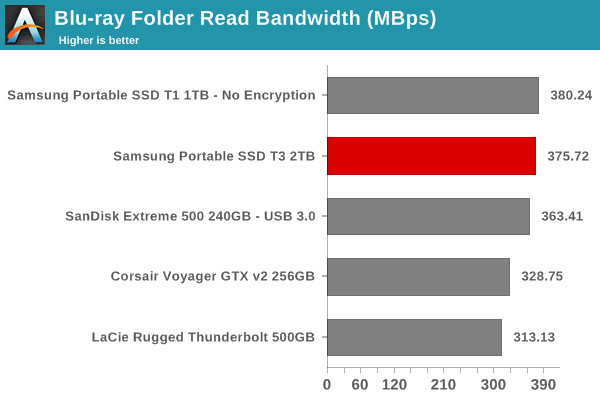
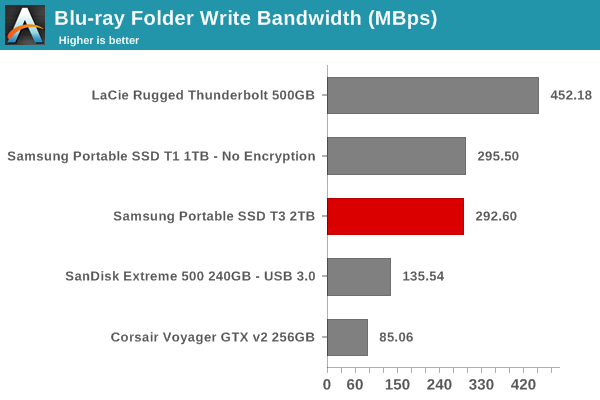
In almost all the cases, we find that the performance of the T3 slightly lags the performance of the T1. However, it is still faster than most other SSDs behind a SATA - USB bridge chip.
For the second use-case, we take advantage of PC Mark 8's storage bench. The storage workload involves games as well as multimedia editing applications. The command line version allows us to cherry-pick storage traces to run on a target drive. We chose the following traces.
- Adobe Photoshop (Light)
- Adobe Photoshop (Heavy)
- Adobe After Effects
- Adobe Illustrator
Usually, PC Mark 8 reports time to complete the trace, but the detailed log report has the read and write bandwidth figures which we present in our performance graphs. Note that the bandwidth number reported in the results don't involve idle time compression. Results might appear low, but that is part of the workload characteristic. Note that the same testbed is being used for all DAS units. Therefore, comparing the numbers for each trace should be possible across different DAS units. These benchmarks also point to the T3 being slightly behind T1 in performance.
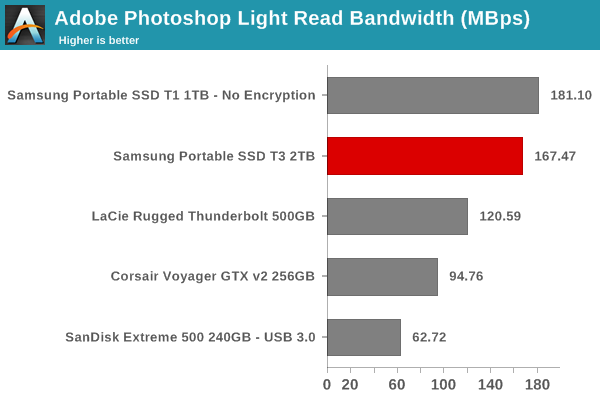
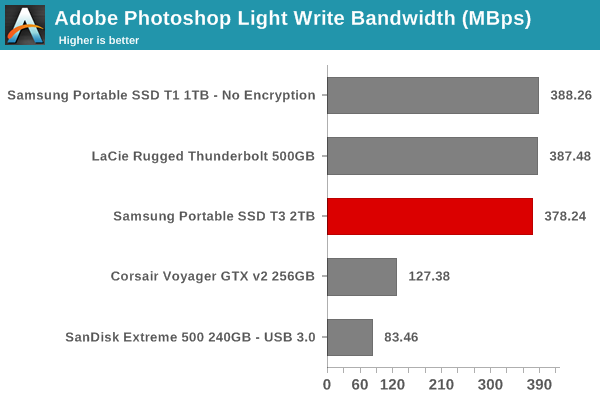
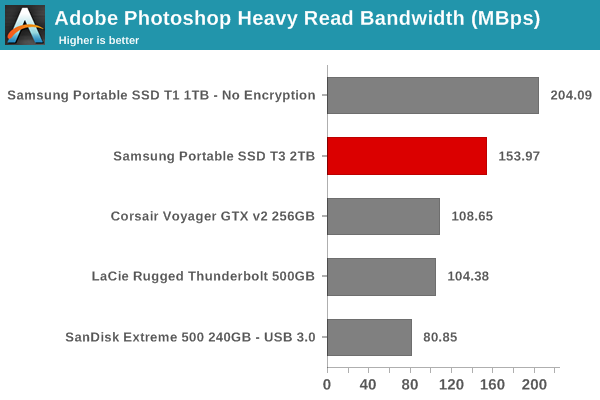
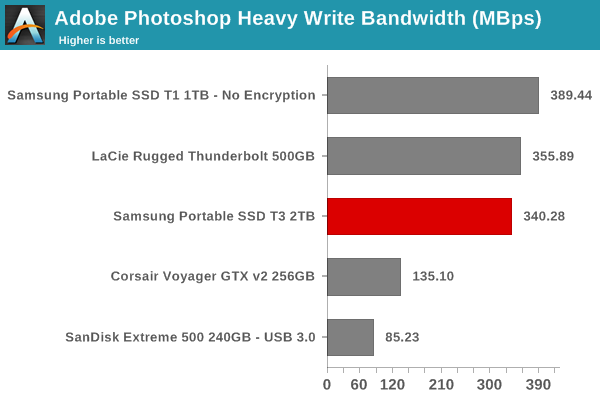
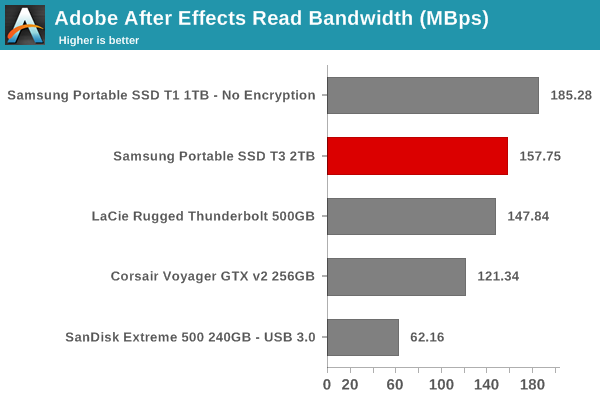
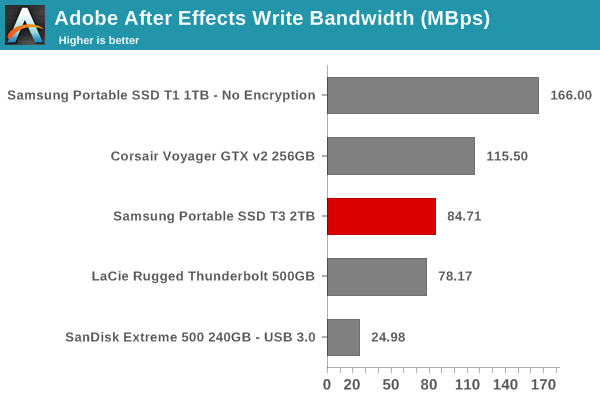
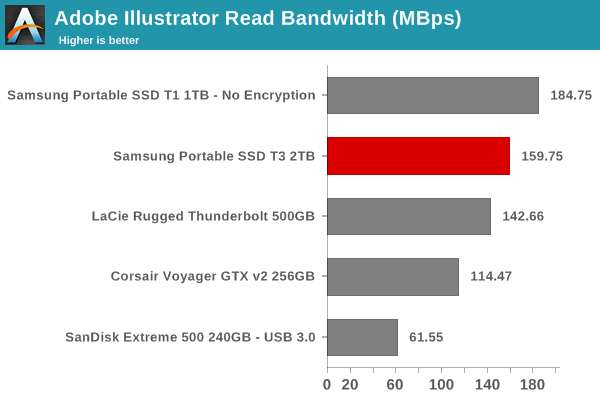
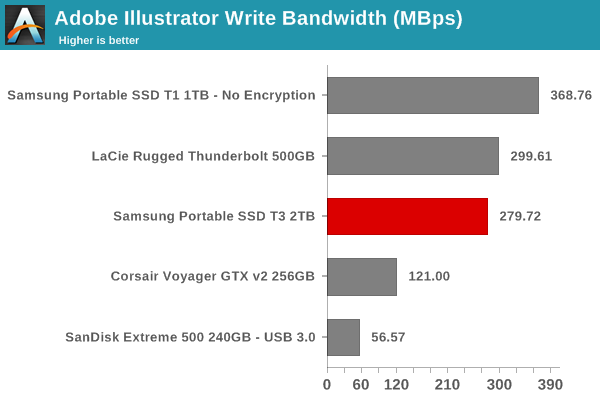
Performance Consistency
An interesting aspect of these types of DAS units is performance consistency. Aspects that may influence this include thermal throttling and firmware caps on access rates to avoid overheating or other similar scenarios. This aspect is an important one, as the last thing that users want to see when copying over, say, 100 GB of data to the external, is the transfer rate going to USB 2.0 speeds. In order to identify whether the drive under test suffers from this problem, we instrumented our robocopy DAS benchmark suite to record the flash drive's read and write transfer rates while the robocopy process took place in the background. For supported drives, we also recorded the internal temperature of the drive during the process. The graphs below show the speeds observed during our real-world DAS suite processing. The first three sets of writes and reads correspond to the photos suite. A small gap (for the transfer of the videos suite from the primary drive to the RAM drive) is followed by three sets for the next data set. Another small RAM-drive transfer gap is followed by three sets for the Blu-ray folder.
An important point to note here is that each of the first three blue and green areas correspond to 15.6 GB of writes and reads respectively. Throttling, if any, is apparent within the processing of the photos suite itself. It is obvious that the transfer rates are quite consistent and there is no throttling at play here, unlike the T1. In addition, the T3 also manages to remain a full 20C below the T1 for the same workloads. While the T1 reached a toasty 75C internally after more than 250 GB of continuous reads and writes, the T3 only reaches 54C for the same.
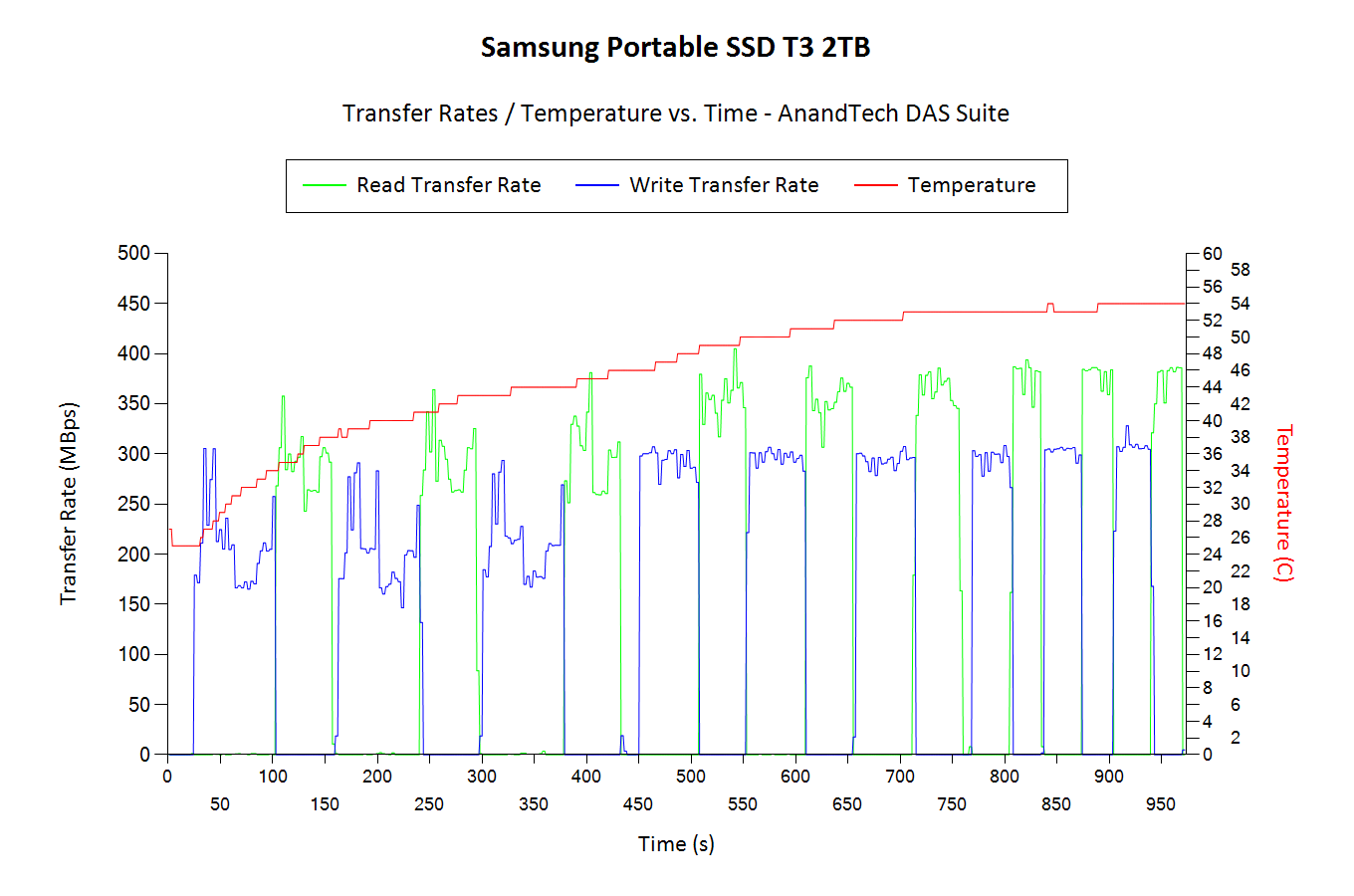
Concluding Remarks
The Samsung Portable SSD T3 is a unique product - it is the only palm-sized bus-powered direct-attached storage unit with a 2TB capacity in the market right now. In addition to the 2TB capacity (priced at $850), we also have the 1TB, 500GB and 250GB variants at $430, $220 and $130 respectively.
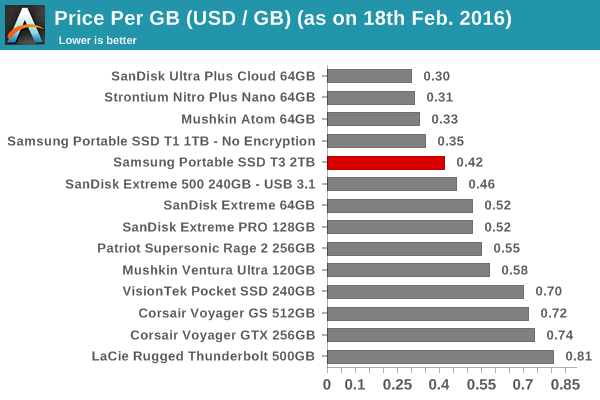
The closest competitor to the Samsung Portable SSD T3 is SanDisk's 1.92TB Extreme 900 Portable SSD. At $800, it is a bit cheaper, but has a bigger footprint compared to the T3. The Extreme 900 also comes with a USB 3.1 Gen 2 interface and boasts speeds of up to 850 MBps compared to the T3's 450 MBps. These are aspects that we would like Samsung to consider for the next iteration. In a bus-powered enclosure, it is difficult to incorporate PCIe SSDs. However, it would have been really nice to have a faster version to go along with the capacity bump in this generation. The slight retrogression in performance over the T1 is also a small cause for concern. In terms of usage on mobile platforms, it would be nice to have exFAT access capabilities in the Android app. In addition to the provided Type-C to Type-A cable, we would have also liked a Type-C to Type-C cable for the price of the unit. Even though the price per GB ($0.425/GB) is lower than the T1's at launch ($0.60/GB), the recent trend towards cheaper flash memory makes it a bit difficult to digest the premium.
Other than the above aspects, there is really nothing much to complain about the T3. The thermal characteristics are excellent (way better than that of the T1). There are plenty of thermal pads protecting the flash packages. The construction of the unit should help it withstand rugged handling conditions that such a small unit is bound to undergo. The metal enclosure helps in heat dissipation and also provides a more premium feel compared to the all-plastic T1. The AES-256 encryption process / password protection works seamlessly (unlike the T1, where the unit had a separate FAT32 partition), even in Android. The flash density is unparalleled. Anyone looking for a secure high-capacity, small-sized direct-attached storage unit would do little wrong in going with the Samsung Portable SSD T3, as long as the price premium is acceptable.

